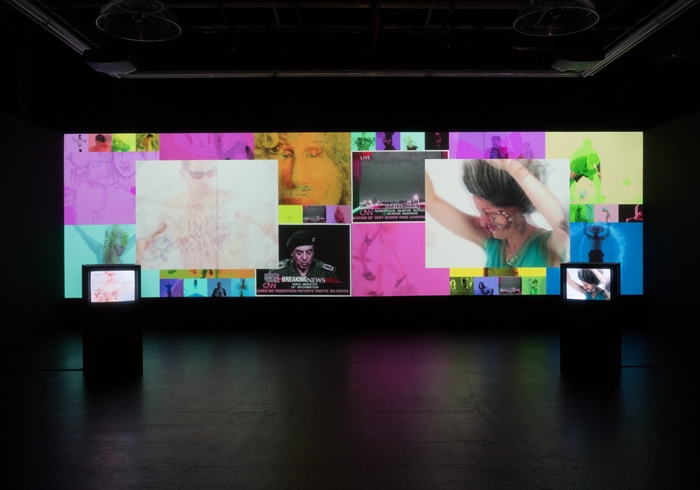In 2003, already three decades into an influential career as a filmmaker and video artist, Charles Atlas was hired as a consulting director for Art21: Art in the Twenty-First Century, a US TV show produced and aired by the Public Broadcasting Service. A generation of viewers has been exposed to the lives of working artists by Art21, and Atlas’s legacy, which he built over four seasons with the programme, is exemplified by the circa-two-minute introductory monologues he directed for season two. Merce Cunningham does a tap-dance solo to illustrate ‘Time’, that season’s third episode. Comedian Margaret Cho shares her irreverent philosophy in ‘Humor’. And for ‘Stories’, director John Waters delivers the line: “I love collecting art, because it makes other people insane.” Far from creating anodyne public television, Atlas provoked viewers in campy set-pieces with video effects such as colour blocking, parallax scrolling and wacky wipes – and his palette was always slightly off. Art21 was a regular feature of my college art-education, and though my professors most often meant to illustrate specific techniques (eg woodworking), the show actually intimated another, better lesson: be generous, because the best mysteries reveal how they’re made.
Atlas’s video portraits for Art21 manage to spotlight art’s (and artists’) most enigmatic features, without losing any fun or approachability. His exhibition the past is here, the futures are coming confirms how his combination of openness, cheeky wit and love for spectacle made him the perfect champion of artists in the American television arena. His back-catalogue runs deep, and the front galleries grant a refresher to video from the past 40 years. There are classics such as the mockumentary Hail the New Puritan (1986), starring dancer Michael Clark, and other dance documentaries produced for television; some of the works pick up from his time as Merce Cunningham Dance Company’s resident filmmaker. Video never looks better than on box monitors, at least that’s the feeling in the midst of four viewing stations that fill the foyer and first gallery. It’s a setup that shows off Atlas’s full range of abilities as a video artist working with dance. I was captivated by Rainer Variations (2002), a technically complex documentary that layers the choreographer’s videotaped studio experiments with interviews Atlas specially shot and overdubbed for the piece. Motivated by Rainer’s skill at picking things apart in a deadpan manner, Atlas finds his through-line in her attempts to teach her minimalist composition Trio A (1978) to the drag performer Richard Move. There is simply nothing minimal about Move, and his interpretations are a foil to Rainer’s humour and touching reserve.
The two installations in the main gallery continue Atlas’s ode to video. The first, appropriately titled The Years (2018), is a five-channel installation that revels in montage. For this work, Atlas has segmented his entire oeuvre across four screens, leaving the fifth channel for footage of four young women standing in place. Each of the other monitors is dedicated to one of the last four decades, and as the footage scrolls from one work to the next, cross-channel comparisons facilitate an intergenerational conversation about fashion and style, using the kids in the fifth channel to ground the piece in the present. With its historical focus on bodies in motion, The Years also archives a world lost to HIV/AIDS. The second installation, 2003 (2018), looks back as well, but with a more sphinxlike approach to the passage of time. A tapestry of video portraits blankets the main gallery’s entire rear wall with footage of Atlas’s peers, collaborators and friends, alongside images of former secretary of state Colin Powell and of military strikes in Iraq taken from cable news. The juxtaposition captures a recent generation’s alienation, though the year 2003 is too recent to elicit pure nostalgia (or adequate hindsight), and too distant to feel entirely relevant to the present moment. Revisiting these relationships 15 years later, though, celebrates how time seldom proceeds in a straightforward manner.
The exhibition also includes a ‘variety show’ called The Kitchen Follies. Performances range from drag to dance, vogue to slapstick, community theatre to one deliberately horrifying monologue, and feature both new and old collaborators, with Atlas controlling live video effects on monitors overhead. A phantasmagoria of bodies and souls have been mixed and remixed at Atlas’s position behind the camera or editing table, and the exhibition and after-dark performance medley demonstrate how he has remained a vital contributor to the downtown scene for the last 50 years. Only here or there do we ever get a glimpse of the artist himself, though. Which is why I cherished The Kitchen Follies’s opening number. Halfway through, Atlas generously shows us who’s behind the spectacle, when he gets out from behind his video-mixing station to dance.
Charles Atlas: the past is here, the futures are coming, The Kitchen, New York, 28 March – 13 May 2018
From the Summer 2018 issue of ArtReview
